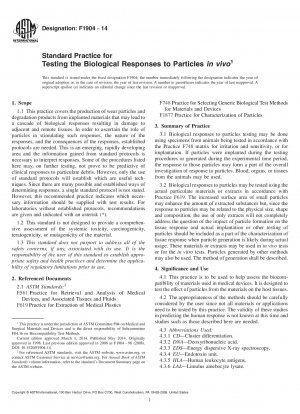ASTM F1904-14
Standard Practice for Testing the Biological Responses to Particles in vivo
- Standard No.
- ASTM F1904-14
- Release Date
- 2014
- Published By
- American Society for Testing and Materials (ASTM)
- Status
- Replace By
- ASTM F1904-23
- Latest
- ASTM F1904-23
- Scope
4.1 This practice is to be used to help assess the biocompatibility of materials used in medical devices. It is designed to test the effect of particles from the materials on the host tissues.
4.2 The appropriateness of the methods should be carefully considered by the user since not all materials or applications need to be tested by this practice. The validity of these studies in predicting the human response is not known at this time and studies such as those described here are needed.
4.3 Abbreviations Used:
4.3.1 CD—Cluster differentiation.
4.3.2 DNA—Deoxyribonucleic acid.
4.3.3 EDS—Energy dispersive X-ray spectroscopy.
4.3.4 EU—Endotoxin unit.
4.3.5 HLA—Human leukocyte antigens.
4.3.6 LAL—Limulus amebocyte lysate.
4.3.7 LPS—Lipopolysaccharide (endotoxin).
4.3.8 RNA—Ribonucleic acid.
1.1 This practice covers the production of wear particles and degradation products from implanted materials that may lead to a cascade of biological responses resulting in damage to adjacent and remote tissues. In order to ascertain the role of particles in stimulating such responses, the nature of the responses, and the consequences of the responses, established protocols are needed. This is an emerging, rapidly developing area and the information gained from standard protocols is necessary to interpret responses. Some of the procedures listed here may, on further testing, not prove to be predictive of clinical responses to particulate debris. However, only the use of standard protocols will establish which are useful techniques. Since there are many possible and established ways of determining responses, a single standard protocol is not stated. However, this recommended practice indicates which necessary information should be supplied with test results. For laboratories without established protocols, recommendations are given and indicated with an asterisk (*).
1.2 This standard is not designed to provide a comprehensive assessment of the systemic toxicity, carcinogenicity, teratogenicity, or mutagenicity of the material.
1.3 This standard does not purport to address all of the safety concerns, if any, associated with its use. It is the responsibility of the user of this standard to establish appropriate safety and health practices and determine the applicability of regulatory limitations prior to use.
ASTM F1904-14 Referenced Document
- ASTM F1877 Standard Practice for Characterization of Particles
- ASTM F561 Practice for Retrieval and Analysis of Implanted Medical Devices, and Associated Tissues
- ASTM F619 Standard Practice for Extraction of Medical Plastics
- ASTM F748 Standard Practice for Selecting Generic Biological Test Methods for Materials and Devices
ASTM F1904-14 history
- 2023 ASTM F1904-23 Standard Guide for Testing the Biological Responses to Medical Device Particulate Debris and Degradation Products
in vivo - 2014 ASTM F1904-14 Standard Practice for Testing the Biological Responses to Particles
in vivo - 1998 ASTM F1904-98(2008) Standard Practice for Testing the Biological Responses to Particles in vivo
- 1998 ASTM F1904-98(2003) Standard Practice for Testing the Biological Responses to Particles In Vivo
- 1998 ASTM F1904-98e1 Standard Practice for Testing the Biological Responses to Particles In Vivo
